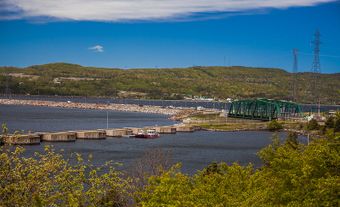A breakwater is a structure built along a shore or offshore, approximately parallel to a shoreline. Some breakwaters float at the water’s surface, while bottom-resting models may emerge from the surface or lie entirely underwater. Breakwaters are different
from dikes because they allow some water flow and do not seal off one portion of a water body from another.

The breakwater and lighthouse at Battery Point, Nova Scotia.
("NS-01428 - Battery Point Breakwater Lighthouse" by Dennis Jarvis at Flickr is licensed under CC BY-SA 2.0)
Function
In most cases, a breakwater serves two main functions. First, it may be built to absorb the force of incoming waves and currents in order to create a zone of calmer waters. This also protects roads, ships and structures from those waters. Second, it may be built to control the rate of erosion or sediment deposit alongshore. This allows the shape of the shoreline to be controlled over time. Both of these functions are important in the face of climate change. Breakwaters can help to hold back rising waters, thus protecting homes and other infrastructure. Similarly, beaches that are being eroded due to rising sea levels may be maintained through the use of breakwaters.
In the 21st century, more and more breakwaters also help make calm waters available to the growing fish farm industry.
Breakwaters in Canada
Most Canadian population centres and economically important areas benefit from breakwaters if they are near an ocean or significant body of water. For example, in British Columbia, over 30 harbors or marinas use floating breakwater systems. The breakwater at Ogden Point, near Victoria, BC, is a notable bottom-resting model, completed in 1917. In addition, Vancouver Island itself acts as a natural breakwater for the mainland coast by shielding it from the Pacific Ocean.
Breakwaters are also important to the provinces exposed to the Atlantic Ocean. Countless breakwaters are scattered along their coasts, including within the Gulf of St. Lawrence. Communities in the Great Lakes region that benefit from breakwaters include Toronto, along the shores of Lake Ontario, and Port Elgin, along the shores of Lake Huron.

 Share on Facebook
Share on Facebook Share on X
Share on X Share by Email
Share by Email Share on Google Classroom
Share on Google Classroom



